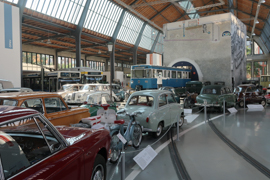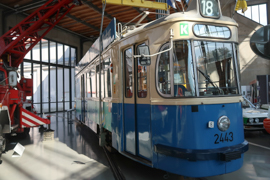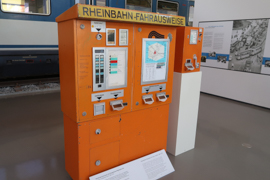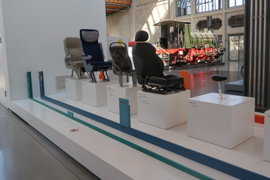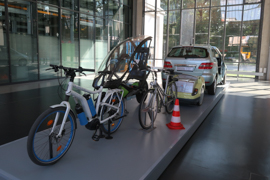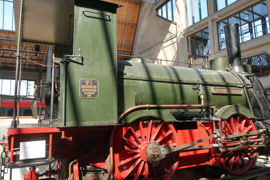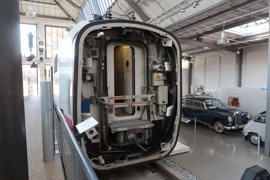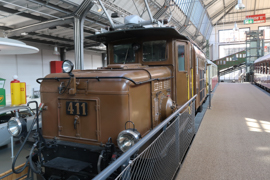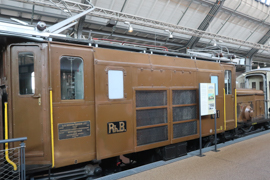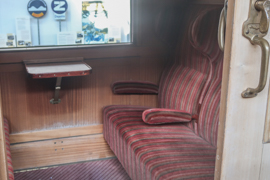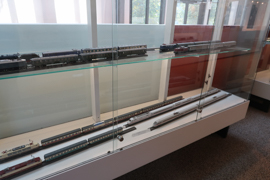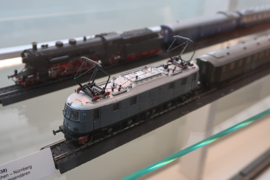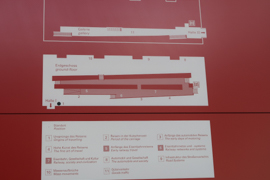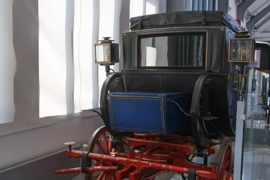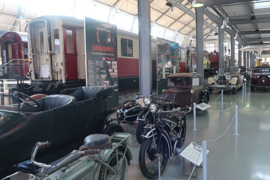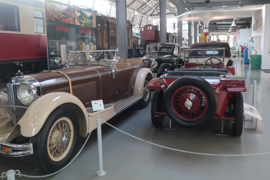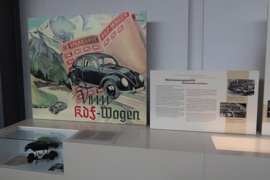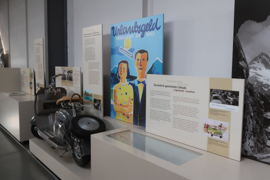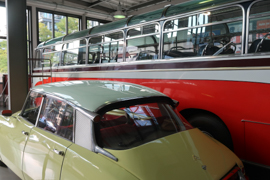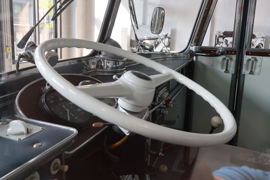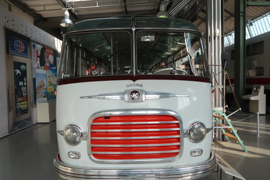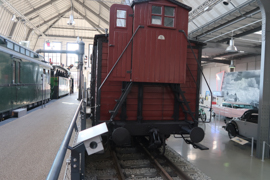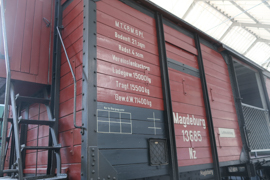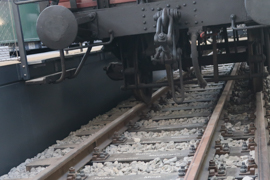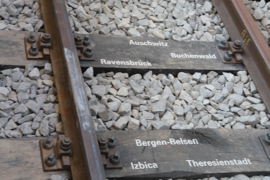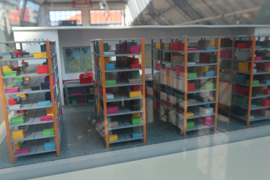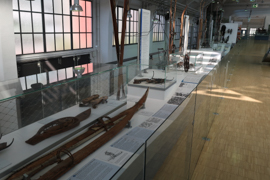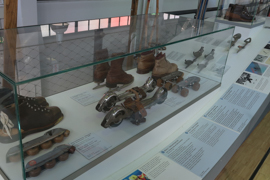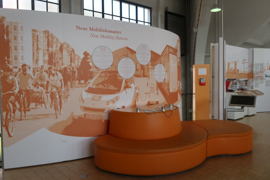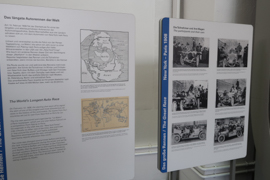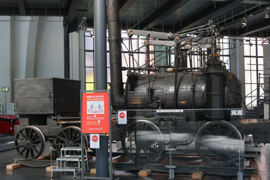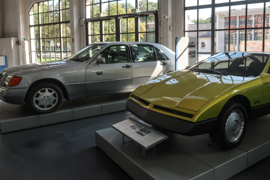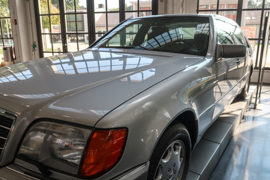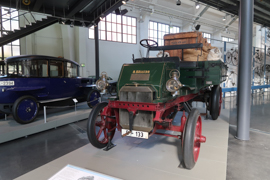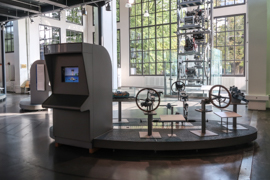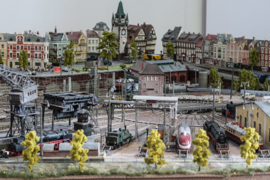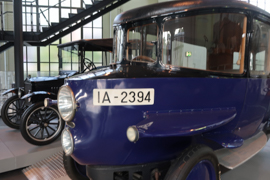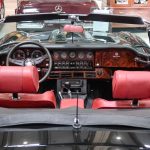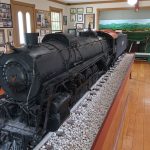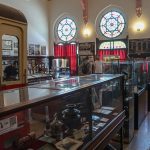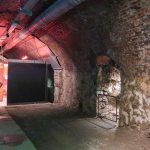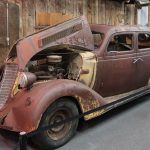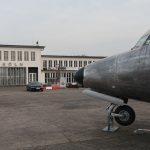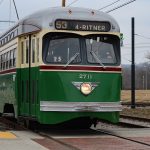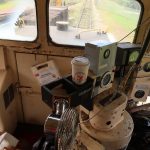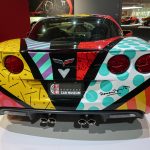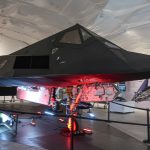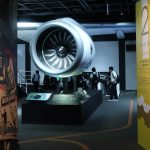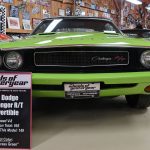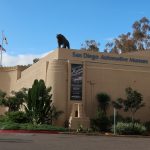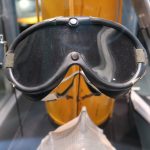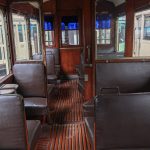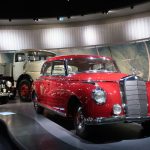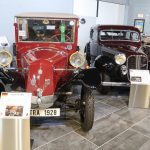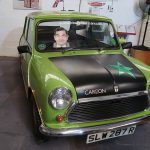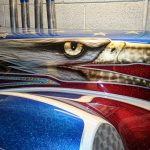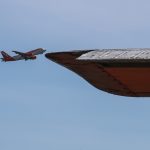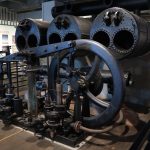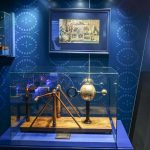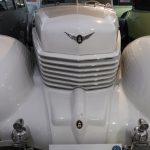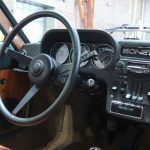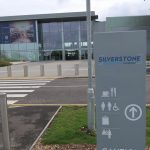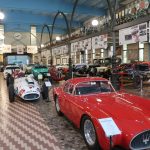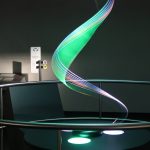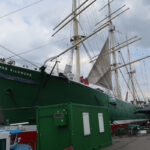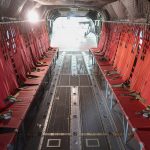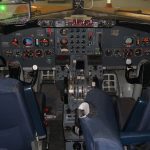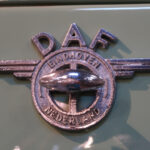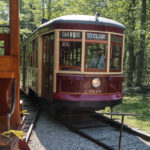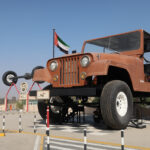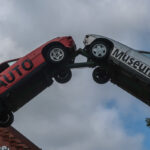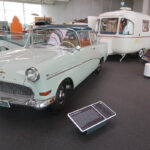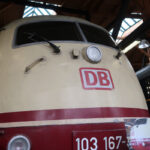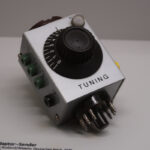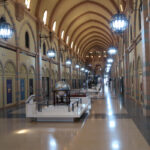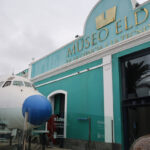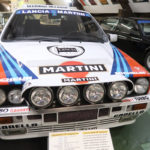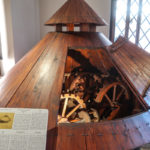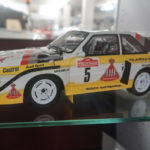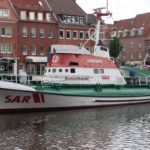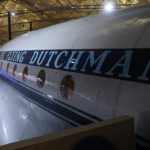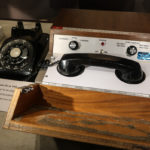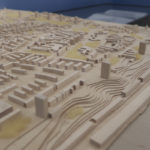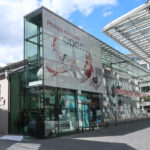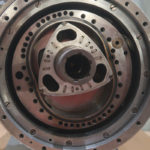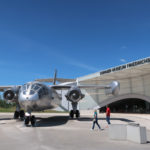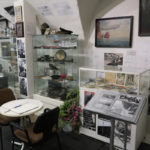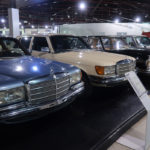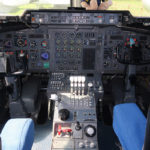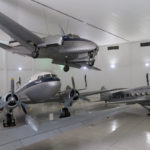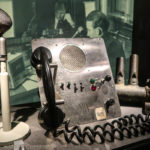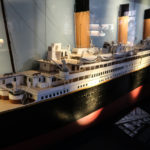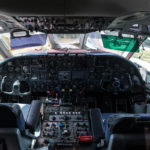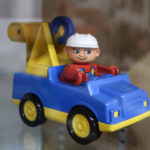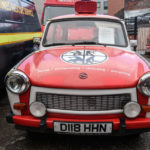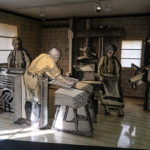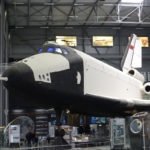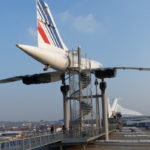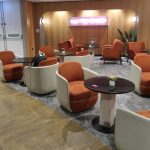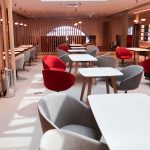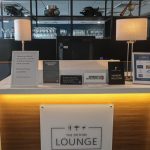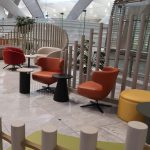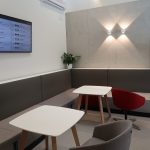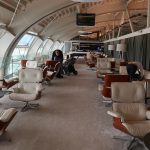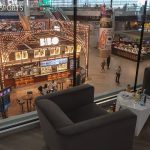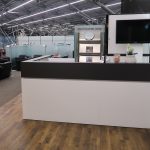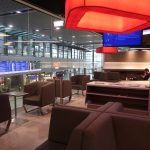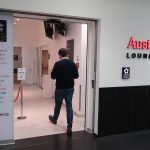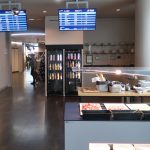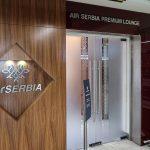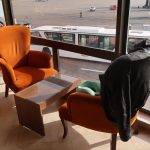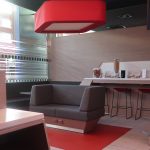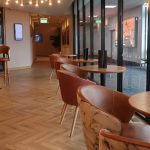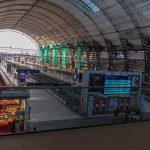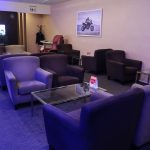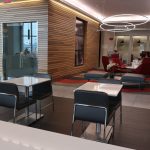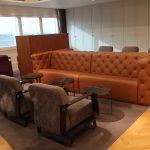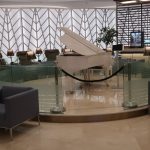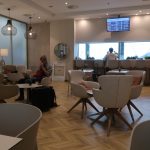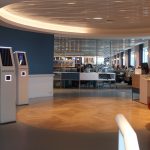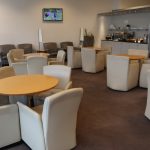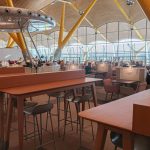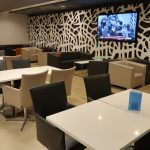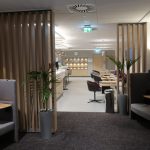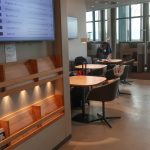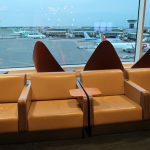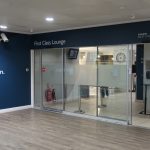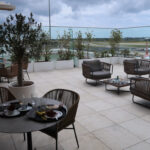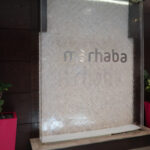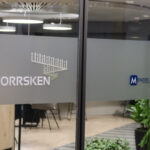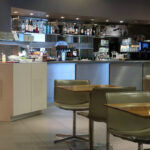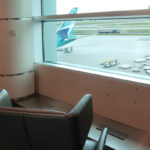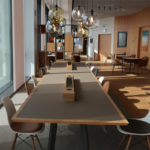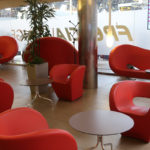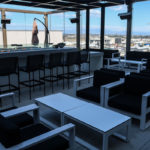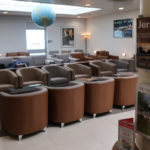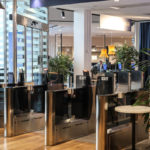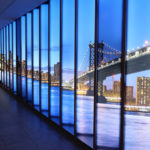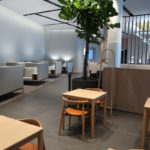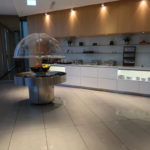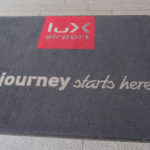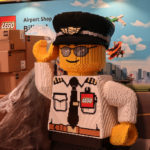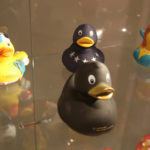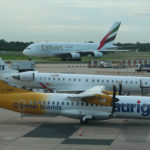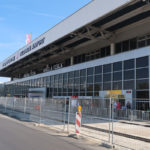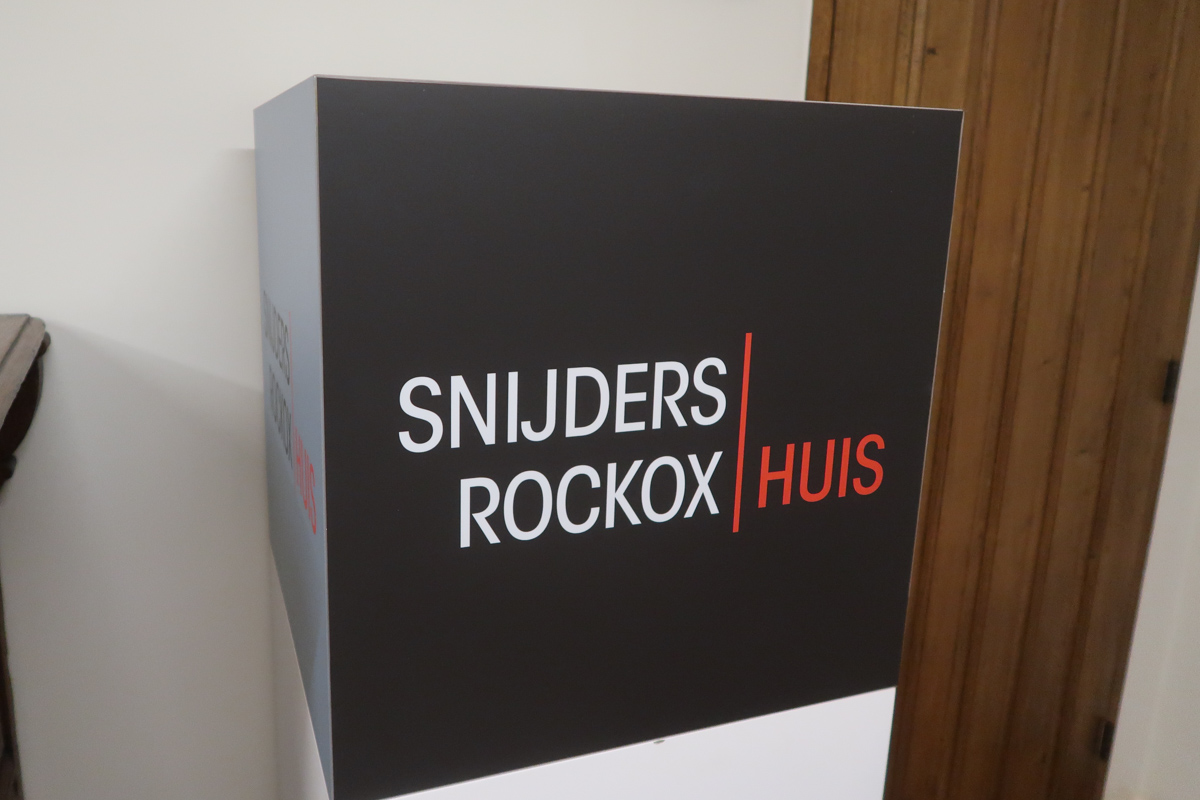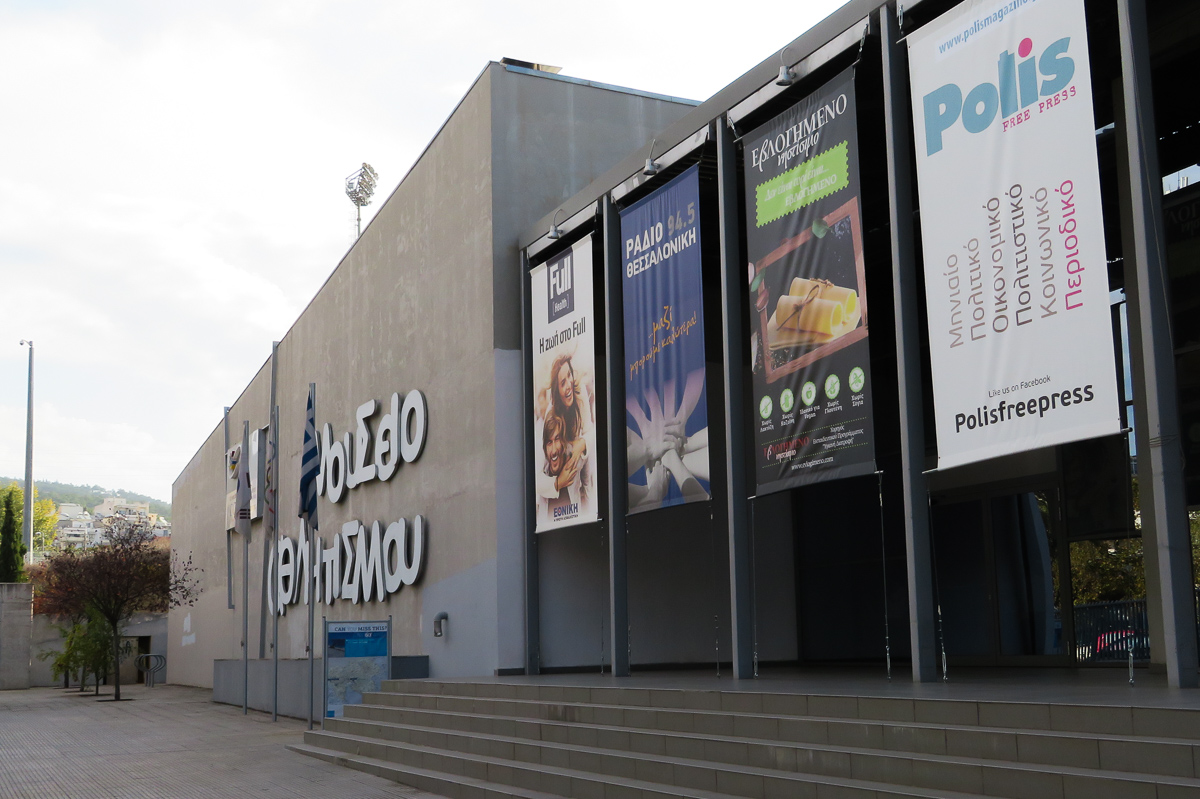Deutsches Museum Traffic Center
7 EUR
Flyctory.com Pros
- Great overview about traffic and travelling
- Very deep exhibition
- Amazing value for money
- Good public traffic connection
Flyctory.com Cons
- No proper refreshment (cafeteria etc.)
The Deutsches Museum (literally: “German Museum”) is an amazing technical and scientific museum in the heart of Munich. While I just did not make it to complete my review of their main outlet, the museum portfolio has grown over time so significantly, that they had to have more and more outlets. I already took you to their aviation museum, the Flugwerft Schleissheim, their outlet Deutsches Museum Bonn and the Lokwelt Freilassing, which is not driven by the Deutsches Museum, but has quite some exhibits in fact owned by them. In this posting I take you to the Verkehrszentrum, the traffic center outlet of the museum group. Located in Munich, it is focusing on all kinds of transport and mobility.



Deutsches Museum Verkehrszentrum – Location & Admission
The Deutsches Museum Traffic Center is located close to the underground station Schwanenthalerhöhe, which is served by the U4 and U5 lines. However, the location is very central, the walking distance to Munich Main Station is some two kilometers. En route, you also pass the Theresienwiese, where the world famous Oktoberfest is taking place. The museum is next to the Bavariapark, a popular recreational area. The museum itself used to be part of Munich historic trade fair.
The museum is opening daily, 9:00 to 17:00 hrs. It consists of three exhibition halls, so that you should at the very least plan for a two hour visit. Adult admission to Deutsches Museum Traffic Center is 7 Euro.
Deutsches Museum Verkehrszentrum – The Visit
Every hall of the Deutsches Museum Verkehrszentrum is dedicated to a special topic. The exhibits are typically documented in German and English, so that it is also easily accessible to foreign visitors. The first hall is dealing with city traffic. It is the largest exhibition space of the three sections. You have a lot of personal cars, but also police cars, trams, police cars, motorbikes and bicycles. You typically cannot enter the vehicles (e.g. the trams), some of that has also been due to Covid-19 restrictions during my visit. There are also some items which are related to urban traffic, e.g. historic ticketing machines.




































Hall II – Traveling
The second hall is about traveling. The center of the hall is paved with tracks and there are a lot of trains and wagons. However, the museum starts much earlier and looks into traveling at Roman times already or the planning and construction of travel infrastructure. One of the exhibits I loved was the mockup of the German ICE high speed train. You also find some carriages, coaches and similar vehicles. Other, rather exotic methods like a Swiss cog railway make you feel being in a rather complete and wide-ranged overview on that topic.






















































Last but not least: one exhibit I loved was also having a typical cargo wagon of the 1930’s and 1940’s. These are very characteristic for being used by the Nazi regime transporting their victims to the concentration and extermination camps. The museum thereby shows that traveling does not necessarily need to be a positive thing, leisure. At first, I approached that part of the exhibition from the wrong side, but then I felt they did a really great job, also naming some of the concentration camps on the ties of the railroad track.











Hall III – Mobility and Technology
You likely visit the exhibition hall in the numbered order and thus finish your stay at the Mobility and Technology hall (before you head back to the main entrance in Hall I). This part of the museum shows, how the desire of mobility drove technical innovation. There are a couple of unique exhibits and prototypes. There are also some more interactive parts than in the two other halls of the museum. This also includes that you learn how tires and another mobility tools have evolved over time. Hall III also comes with a scale model landscape.






































Deutsches Museum Verkehrszentrum – Services
You may rent an audio guide to have a better museum experience. The museum does not drive a cafeteria or similar. You may only refresh yourself at a vending machine section.


Deutsches Museum Verkehrszentrum – My View
Visiting the Deutsches Museum Traffic Center is a great option for technology lovers. The museum is really well done, the documentation is good and it covers a wide range of items. The more you are into the topic, the more time you will spend… This could easily add up to up to four hours.
Technical Museums
Here are all other Flyctory.com postings dealing with technical museums and exhibitions:

In April 2025, I already introduced you to Motorworld Cologne. Their outlet in my home town comes with special features ...

On the ninth day of my Six US States and Nashville trip in summer 2025, I did a detour from the Interstate ...

A railroad museum with good reviews, even though I could hardly find any good information on the internet? The Southern ...

During my May 2025 trip to Istanbul, I did not do too much sightseeing. Quite a lot of stress at ...

I still have quite a backlog of reviews of places and attractions in Florida. Thus, I am very happy to ...

Discover 400 million years of the history of Earth - that's what the Zeittunnel ("Time Tunnel") in Wülfrath is promising. On ...

After having significant luggage trouble during my December 2024 trip to the United States, I had to significantly reduce my ...

Balboa Park in San Diego feels to be a place of a sheer endless number of attractions. Even though I ...

The 2025 Rock of Ages shows in Cologne (I visited all of them...) gave me the opportunity to have a closer ...

The Charité is one of the most famous and best hospitals in Germany. It is driven by the two key Berlin universities, ...

I like public transport of all kinds. Thus, I was really happy that I finally made it to the Pennsylvania ...

I am transportation nerd. Even though there is a certain touch of aviation in that regard on Flyctory.com, I do ...

When I was in Newport, Rhode Island, in summer 2024, I unfortunately did not have too much time to visit ...

Before I visited Rytiri Kladno in the Czech ice hockey Ekstraliga, I visited another interesting attraction in the Prague outskirts ...

In the second posting about the Autostadt in Wolfsburg, I take you to the VW ZeitHaus Museum (ZeitHaus translates to ...

On a Sunday in mid-August 2024, I visited the Autostadt ("Car City" or "Motor City"). Located in Wolfsburg in Germany, ...

Apart from having an outstanding Douglas C-47 flight experience with them, I was also really curious about the Palm Springs ...

Mitsubishi is a widespread technology group. Even though their headquarters are in Tokyo, they run an industry museum in a ...

The excellent reviews of Wheels of Yesteryear made me put this place on my bucket list for Myrtle Beach. I ...

Balboa Park in San Diego hosts numerous attractions. The most famous one is likely the San Diego Zoo, which I ...

Unfortunately, I had very limited opportunity to explore the sights in and around Newport, Rhode Island, during my visit in ...

A musieum about nuclear power and atomic bombs? Sounds like a place which is either a great scientific one - ...

During a trip to Liege / Luik in Belgium, i took a short detour from a shopping mall to visit ...

Germany is famous for its car manufacturers. With Porsche and Mercedes, Stuttgart is likely one of the key cities car ...

I still have quite a backlog of reviews of attractions I visited during my recent trips to Florida. Time to ...

Cyprus is full of historic museums, excavation sites and touristic attractions. Why should you care about cars when you are ...

For the second part of my "review battle" of museums dealing with visions around the future, we leave the Museum ...

Honestly, when my wife and I visited the Count's Kustoms Showroom in Las Vegas, we just had very little knowledge ...

Wernigerode being located right North of the Harz mountains might not be the most obvious location for an aviation museum ...

I love historic planes and explore the feeling of flying in a historic manner. For example, I am really happy ...

Is it really New Year's Eve already again? The last day of the year? I am posting this one in ...

Being in Crawley near Gatwick Airport (LGW) by rental car gave me the opportunity to visit the Gatwick Aviation Museum ...

It is well-known to most visitors of Iceland that the Nordic island produces a vast majority of their energy with ...

The Arabia steamboat is something like what the Vasa is for European ship history (just dated a few centuries later...). The side ...

No, this place is not about The Tudors. Henri Owen Tudor might not be in scope of some of you, but ...

Despite just being in the little country for less than 48 hours, I ran into some very interesting sights and ...

Especially as a German aviation enthusiast, being on board of an aircraft carrier is just a cool experience again and ...

When you think about Nashville, you think about country music, partying and music-related attractions like the Country Music Hall of ...

During my trip following the Weird Al Yankovic 2022 Tour in Florida, I also passed the East Coast of the ...

The website states that the Nederlands Spoorwegmuseum (also: Het Spoowegmuseum) is the best train station in the Netherlands. In fact, the ...

A Rock of Ages musical weekend in Milton Keynes gave me the opportunity to visit a place I have been aiming to ...

During my most recent trip to the Emilia Romagna, I also visited the Umberto Panini Collection Motor Museum. Yeah, it ...

If you nowadays look at the map of Cyprus, you won't find any rail-driven vehicles. However, the country did have ...

With Malta being an island, it feels quite obvious that you might expect a rather interesting local history of air ...

Especially when I visit large places for Flyctory.com, which give me a lot of memories - and pictures - I ...

I love unique places, weird locations - and even mark them by the Flyctory Obscura tag - The more I ...

Lüdenscheid in the Sauerland region of Germany, Southeast of Dortmund, might not be on the top of the list when ...

BMW - the Bayerischen Motoren Werke are definitely one of the most famous companies of Munich and a synonym for German ...

The museum at the Schwelmer Straße 41 is not exactly at birthplace of Wilhelm Conrad Roentgen - but it is just a ...

The harbor area is the heart of the German city of Hamburg. The history of the city is closely linked ...

Despite the country as such is rather small (measured by the number of people, not by area), Iceland has some ...

One of the largest aviation museums of the world is in fact located in Krakow, Poland. Thus, it was not ...

The last stop of a trip through Italy in late summer 2021 lead me to Volandia, an aviation museum (and ...

At the beginning of July, my wife and I visited the LWL Freichlichtmuseum Hagen, the LWL Open Air Museum in Hagen. The ...

Flugsafn Islands - or the Icelandic Aviation Museum - has of course been a attraction I just could not miss while ...

Van Doorne’s Automobiel Fabriek is typically known as DAF. The company has been founded in 1928 in Eindhoven. While the ...

I felt really happy to have a deeper view to the Northern and East parts of the United Arab Emirates ...

During my trip to Canada right after the borders have been opened again in September 2021, I visited a very ...

A museum full of computer games and gaming history? The German capital can offer that one! Right in the city ...

Even though people might initially think about Lamborghini and Ferrari when it comes to Italian sports car, Alfa Romeo is ...

National Emirati people love cars - and if they are close to the reigning families, they are typically also rather ...

During a trip to the German North Sea shore in later 2021, we also visited the Automobil- & Spielzeugmuseum Nordsee. The ...

Campers, motor homes or recreational vehicles - no matter how you call do have your hotel room with you during ...

The region of Stuttgart is one of the key car manufacturing areas of Germany. Thus, it has been not too ...

The Lokwelt Freilassing is one of the most famous train museums in Germany. During a trip through Bavaria, I had ...

The Gloster Aircraft Company (the original name has been Gloucestershire Aircraft Company) has been active from 1917 to 1961. The most ...

Hauptstadt der Spione - "Capital of the Spies". This is a book, which you can buy at the souvenir store of ...

In quite some postings about the emirate North of Dubai, I already stated how much I value and enjoy the ...

If you are at Gran Canaria and dare to head away from the beaches, there is a quite wide range ...

Even though my summer 2021 trip to the Emilia-Romagna was majorly featuring the two Ferrari Museums in Maranello and Modena, ...

The place the red cars with the horse in the logo made famous: after I already introduced you to the ...

From outside, the Auto & Traktor Museum Bodensee ("Car and Tractor Museum") at Lake Constance looks like a traditional old farm ...

Before flying back from Graz Airport (GRZ) to Frankfurt, I just had to head South of the terminal area. Right ...

Ship lifts are one of the most fascinating technical constructions to me. Being able to move ships like in an ...

If you think about oil producing countries, you may think about the USA or the United Arab Emirates. In fact, ...

As I said in other posting, I really enjoy being in Sharjah and feel the vibe of the city and ...

The place where the story of the famous (typically) red cars started? Walking on the routes of the Ferrari company ...

My trip to the Bodensee / Lake Constance region in summer 2020 brought me to a surprisingly large number of car ...

Professional stargazing: The European Southern Observatory, short ESO is a collaboration of multiple European countries to gather astronomic forces on the ...

A museum with an amazing collection of luxury and top-class racing cars, driven for the cause of charity. This is ...

The story why I felt I had to visit the Bergisches Museum für Bergbau, Handwerk und Handel - the Bergisches ...

The German Movie Museum - or: Deutsches Filmmuseum is located in the heart of Frankfurt (Main). It gives you an overview about ...

In February 2020, I visited a lovely aviation museum in Santa Ana, Greater Los Angeles: the Lyon Air Museum is ...

The Cap San Diego is a general cargo vessel, which has been in duty between 1962 and 1986. Since then, it ...

If an industrial site is jokingly called the Eiffel Tower of the Ruhrgebiet Region, it seems to be quite an impressive ...

Zeppelinheim - the nominal reference in the name of the borough South of Frankfurt to the legendary German airships is ...

I am really fascinated by Leonardo da Vinci and his concepts / inventions. Thus, during my summer 2020 visit to ...

A museum with 90 vintage cars and so-called Yountimers might not feel to thrilling. If you add that about half of ...

Even though I could likely never have a maritime life (I would feel too locked away on a ship), I ...

The Aviodrome in Lelystad in the Netherlands calls itself a Luchtvaart Themapark - an "Aviation Theme Park". You can definitely spent as ...

What would a visit to the Silicon Valley be without at least visiting one computer museum? Duing my February 2020 ...

The marketing flyer of the Museum Prototyp in Hamburg is really self-confident. The name of the car history museum is not ...

I already presented you my review of Carnegie Science Center in Pittsburgh. As its key attraction is that special, I ...

The Louwman collection, nowadays driven by the son of founder Pieter Louwman, Evert, is a private collection of oldtimer cars ...

Even though architecture is a topic which so much influences our everyday life, the German Architecture Museum (Deutsches Architekturmuseum - ...

Some cities are economically dominated by one big company player (which can have good and bad effects). Eindhoven in the ...

The Carnegie Science Center is one of the best rated attractions in Pittsburgh. Of course, I have visited the nicely ...

The Deutsches Museum (German Museum for Science and Technology) in Munich is one of the most fascinating places in Germany ...

Though there is the amazing tiny Zeppelin Museum in Meersburg, not too far away, people tend to think about the ...

Hangar 7 at Salzburg Airport, driven by (likely) the world leader of energy drinks, is a quite popular and well ...

What is Germany's most popular tourist attractions? According to many popular rankings including TripAdvisor, it is neither the Brandenburg Gate ...

Aviation fans likely first think about the zeppelins when it comes to Friedrichshafen, Germany. However, the city is also home ...

A museum for home computers feels like a technical reflection of my biography. I personally started with an Atari 800 ...

Las Vegas offers entertainment for everybody. One of the places which I love most in the city is definitely the Pinball ...

The Imperial War Museum operates five sites throughout Britain. While I already visited the interesting Churchill War Rooms, I was ...

Out of my archived postings, it is sometimes very hard to find the right option to publish next on Flyctory.com ...

Air ship and zeppelin flights / flight history is a quite popular part of a visit at Lake Constance. In ...

I am not too much of a casino person. However, I love being in Las Vegas as it is also ...

You are free to mention the Colts (see my review of the Lucas Oil Stadium Tour), but finally, if you ...

In close proximity to Sharjah Airport, there is the Sharjah Classic Car Museum. On my November 2019 trip through the ...

The De Havilland company is a huge name in the aviation history, especially regarding British aviation history. Close to the ...

A Calculation Museum? Sounds like a place for die-hard nerds - but the Arithmeum in Bonn is really a popular ...

If you look at the mega-airport of Dubai International nearby, it is hard to believe that Sharjah once was the ...

There are quite many museums about civil emergency services. After I visited the amazing National Emergency Services Museum in Sheffield ...

I am sure you know all the details (non-fictional and dramatic ones) about the tragic end of the RMS Titanic ...

The next cities around are Trier, Sankt Wendel or Idar-Oberstein - the small city of Hermeskeil could be seen as ...

Video Gaming and arcade machines have been a significant part of my life. I grew up with an Atari 800XL, ...

Not just due to my favorite flight with LATAM from Frankfurt to the Spanish capital, I love being in Madrid ...

When I select the places I want to visit in a city for flyctory.com, there are typically two kinds sights: ...

The historic Cental Fire Station is one of the most iconic landmarks in Singapore. While you likely pass by this ...

On the return trip from Singapore and Malaysia, I had more or less a whole day around Manchester before I ...

Just around all the National Historic sites in Philadelphia, there is a load of additional museums, which are more or ...

If you use the Madrid Metro Line 1 between Bilbao and Iglesia, you will likely notice that you pass another ...

Ever dreamed of becoming a fire fighter or a policeman? Maybe the National Emergency Services Museum in Sheffield is the ...

During a weekend stay in Sheffield, where I had an overnight due to a Mike & The Mechanics concert, the ...

My first steps around O2 Arena in London during the Country 2 Country Festival 2019 were not motivated by country ...

Bergisch Gladbach, a 110,000 inhabitant city East of Cologne, is a traditional location for the production of paper. While nowadays, ...

After I visited the Sinsheim sister museum in February, I have been very curious about visiting the Speyer Technology Museum ...

The area feels like nomansland in the desert - but when you take a 30 minute Southbound drive from Abu ...

One of the key attractions in Ratingen, Northeast of Dusseldorf, is the remarkable Cromford Textile Factory, which is driven by ...

As an aviation nerd, I just had to visit the quite well-rated Finnish Aviation Museum (Suomen ilmailumuseo), which is located ...

Due to the limited exhibition space of the "Deutsches Museum" (German Museum of Technology), the famous Munich educative center had ...

Being a UNESCO World Heritage for its famous colorful city center and harbor area, it is not that surprising that ...

Located quite prominently right at the motorway A6 at Sinsheim (home of the TSG Hoffenheim soccer club), the Technik Museum ...
Lounge Reviews on Flyctory.com
Here are all Lounge Reviews on Flyctory.com:

Like at most Spanish airports, the lounges are driven by the Spanish Aviation authority AENA. During my September 2025 trip ...

My American Express Platinum card offers me access to a couple of lounges driven by the credit card provider. After ...

Even though I have a long list of flights to and from London Heathrow Airport (LHR), my history with Terminal ...

Saturday noon rides with German national rail Deutsche Bahn typically give me a good chance for some lounge reviews. While ...

Visiting a friend's musical performance in late June 2025 did not only give me my very first flights to and ...

After two Weird Al Yankovic shows in June 2025, it was time to fly home. As American Airlines, who took ...

As the Pearl Lounge in Abu Dhabi Airport (AUH) is contracted to Qatar Airways and Sri Lankan Airways, I visited ...

I am a transport and aviation nerd. Thus, it might not be too surprising that one of the key motivations ...

The name Centurion Lounge is just located in comparably small letters at the side of the staircase - the credit ...

Returning from the Swedish Floorball Finals in April 2025, I chose a Eurowings flight from Stockholm Arlanda Airport (ARN). While ...

On my trip to Bremen and Stockholm in May 2025, I had quite some time to spend before a Rock of ...

It's already quite a while ago since I shared my view on Dubrovnik Airport (DBV) with you. However, I did ...

On my recent twelve Air France and KLM mileage run in January 2025, I also had one night in Malaga ...

Having a Thursday evening flight with British Airways gave me a comparably rare opportunity for a lounge review at my ...

While in Vienna in January 2025, I did a bit of travel nerd things. Among other rail experiences, I was ...

In October 2024, I flew from Jakarta (CGK) Terminal 3 back to Abu Dhabi (AUH) via Colombo (CMB). The SriLankan ...

Flying Eurowings in the A320neo from Cologne/Bonn (CGN) to Dubai World Central (DWC) did not only give me my first-ever ...

I have been at the Schengen Austrian Airlines Senator Lounge in Vienna (VIE) so many times the last years. However, ...

In addition to the non-Schengen services at Terminal 1, Terminal 2 of Prague Airport (PRG) offers two lounge options. I ...

Flying Qatar Airways Business Class from Belgrade (BEG) to Doha (DOH) gave me a rather rare experience. While I already ...

The lounge Josh Cahill made famous - the Privilege Lounge at Tunis Airport (TUN) once made a devastating YouTube video ...

Being on some sort of Lufthansa farewell tour after I decided not to prolong my Senator status gave me an ...

While most of my lounge reviews deal with airport and airline lounges, I am always flattered to also visit lounge ...

Four flights with SriLankan Airlines - the national aviation provider of the Asian state was the backbone of my travel ...

My October 2024 trip, featuring multiple flights and airlines from Germany to Jakarta, came with one major highlight. Qatar Airways ...

Before my flight back with Saudia Arabian Airlines from Kuala Lumpur (KUL) in late February 2024, I expected to have ...

Even though I already had a couple of flights from Newcastle Airport (NCL), I never shared my lounge experience from ...

Being the only guest in a lounge almost demands me having a lounge review. This happened to me in Dresden ...

My Firefly flights in Malaysia to and from Subang Airport (SZB) also offered me to explore a new lounge. The ...

On my recent trip to the Tennis Hall of Fame Open 2024 in Newport, I had British Airways and American ...

Opting for American Airlines over British Airways when flying from London-Heathrow (LHR) to the United States has a key advantage: ...

On a business class trip with Finnair from Lissabon (LIS) to Helsinki (HEL), I had the opportunity to check out ...

A roughly eight hour transfer time in Jeddah (JED) - some people would not have booked the trip I took ...

I am very likely not prolonging my Lufthansa Senator status after it expires in February 2025. Thus, when my wife ...

After I already introduced you to the Carlsberg Aviator Lounge in Copenhagen (CPH), I had the opportunity visiting its sister ...

I haven't been to Birmingham for quite before in December 2023. Thus, my flight from Birmingham (BHX) to Dusseldorf (DUS) ...

As my trip to the Faroe Islands in September 2023 was on two split tickets, a SAS one from Dusseldorf ...

One thing how you can easily proof that I am a nerd: one reason I was looking forward flying Finnair ...

Typically when I fly from the B Gates at Frankfurt Airport (FRA), I love opting for the Air Canada Maple ...

Terminal 3 of Heathrow Airport (LHR) is something like the safe haven for British Airways Executive Club (BAEC) status customers ...

In July 2023, I did a try-out flight with Air France and KLM, exploring whether they could replace German carrier ...

Yeah, I am a bit of nerdy, but one thing I was looking forward about flying Lufthansa First Class from ...

What sounds better like having a beer or two (or three....) while you are waiting for your flight in the ...

As far as I had in mind, there used to be two business lounges at Krakow Airport (KRK). The more ...

In late July 2023, I have been checking out some of the services of KLM and Air France, testing if ...

Aiming to intensify my travels with the oneworld Alliance members also leads to a more frequent visit of their business ...

The first day of our Iceland Ring Road trip brought my wife and I to the Air France / KLM ...

If you have a Schengen flight from Madrid Barajas Terminal 4 and fulfill the requirements, you typically relax at the ...

Travelling to the very last Rock of Ages shows by the British DLAP production company brought me to Swansea in Wales. The ...

The Aspire Lounge at Manchester Airport (MAN) Terminal 2 is in fact the third Aspire Lounge I introduce you to ...

Especially with British Airways moving the vast majority of their operations from B-Gates to C-Gates, I have been frequently visiting ...

Primeclass is a global franchise of airport lounge operators. During our Croatia Airlines flight from Dubrovnik (DBV) to Frankfurt (FRA) ...

In January 2023, I took a rail trip hitting all 16 German states in one day. Apart from that geographic ...

My March 2023 flights to some Pittsburgh Penguins matches had a nice highlight from an aviation point as well. For ...

A short stay at Marrakech Airport (RAK) in January 2023 gave me a couple of debuts: first of all, it ...

Damn, it is already four years... And it is more than 2,750 postings since then. On 25th February 2018, I ...

Before our Lufthansa Business Class flight back from Larnaca Airport (LCA) to Frankfurt (FRA), my wife and I had the ...

What a day - on 14th January 2023, I traveled through all 16 German states in a 24 hour train ...

In previous postings, I already introduced you to my excellent travel experience with the Southern Florida high-speed rail provider Brightline ...

The (most of the times) good thing about exploring a new airport? Right before you leave, you have the opportunity ...

On my way back from the 2022 Lillehammer Tennis Davis Cup tie of Norway hosting India, I went back home ...

Unexpected encounter in October 2022: right when I was about to have my first Eurowings Discover intercontinental flight to Tampa ...

Flying back home from a Rock of Ages show weekend in Inverness in the Scottish Highlands, I was really amazed ...

In between of tour-chasing Weird Al Yankovic in Florida in October 2022 (see my picture posting), I also had the ...

Our October 2022 trip to Cyprus lead to an outbound connection from Germany to Larnaca (LCA) with Austrian Airlines. It ...

While flying British Airways from Amsterdam-Schiphol (AMS) in July 2022, the British Airways Lounge had still been closed for refurbishment ...

In June 2022, I had the opportunity to have a (for me) rather unique experience as a rail traveler: right ...

New York LaGuardia Airport (LGA) is not regarded to be the nicest way of air traveling in and around the ...

Old lounge, new lounge: after Lufthansa decided to terminally close down some of their lounges, the company Global Lounge Network ...

I have to admit that I did not become too much of a friend of Malta during our four night ...

Flying back in the Finnair Business Class from Dubai International, Terminal 1, to Helsinki Airport (HEL) has not been the ...

Before heading to the United Arab Emirates in February 2022, flying with Finnair from Helsinki Airport (HEL) to Dubai (DXB) ...

When I flew Finnair from Stockholm-Arlanda (ARN) to Helsinki (HEL) the last time in 2019, the Finnish airline has been ...

What has started as Stuttgart 21 - the refurbishing of Stuttgart Main Station including changing the main travel direction and putting ...

There are a couple of LOT intercontinental flights from Warsaw Airport (WAW) in my flight log. Based on that, I ...

In late August 2021, I flew back from Salzburg Airport (SZG) to Dusseldorf Airport (DUS) with Eurowings. My BizClass ticket ...

While Lufthansa operated their flights from the Emirates Terminal 3 during the Covid-19 flight reductions, I was quite happy to ...

As Munich Airport (MUC) is one of my most traveled ones, I know the business lounge situation there quite well ...

As part of my Condor Business Class experience from Toronto Pearson (YYZ), Terminal 3, to Frankfurt (FRA), I also had ...

In August 2021, I finally visited a place which has been hidden from me for so long. I had so ...

I recently reviewed the DB Lounge / German Rail Lounge at Frankfurt Airport. I could somehow copy and paste major ...

For years, if I would have wanted to deeply bash the Deutsche Bahn (German Rails), there would have been a simple way ...

In April 2021, I finally had my first flight connections to/from the new Berlin airport, BER - Berlin / Brandenburg ...

It is still uncertain when there will be regular touristic travel between the United Kingdom or Europe and North America ...

After visiting so many German Rail lounges in my life, I was really looking forward how the more exclusive waiting ...

With British Airways' decision to move all short-distance connections including the one to Cologne/Bonn airport to Heathrow, I unfortunately will ...

Though they really seem to put in quite some effort to improve the situation, I am not too much a ...

Right before the United Kingdom left the European Union, I headed to Jersey for a short mileage run. The Channel ...

While my Lufthansa Senator Status typically grants me access to the SAS Gold Lounge next door, a Eurowings BizClass flight ...

If you fly a non-Schengen flight from Terminal 1 (the non-Lufthansa one) at Munich Airport and depart from the B ...

The reviews I found so far are quite clear: 9 out 9 users assigned a 1.0 to the Eurowings Lounge ...

In contrast to the significantly more fancy Flagship Lounges (here is my review of the JFK one), the American Airlines ...

Flying from Stockholm to Helsinki with Finnair in early August 2019 gave me the opportunity to visit a lounge I ...

I have to admit that American Airlines Admiral Club Lounges are not really my favorite place. Some are functional, some ...

Flying intercontinentally from Europe via Helsinki, especially to Asian destinations, became more and more popular the last years. One key ...

After I mentioned the Air Canada Lounge at Frankfurt Airport already in my love letter posting to LATAM flight 705, ...

Starting my trip to the United States on my Weird Al & Grass Court Tennis trip 2019 was the second ...

On my trip with Sun-Air of Scandinavia, I had the opportunity to visit Billund Airport. My stopover time there was ...

For customers flying on Lufthansa's top notch First Class product (and HON Circle Members), the German airline offers a very ...

During my trip to Singapore and Malaysia, I chose Malysia Airlines for my return from Kuala Lumpur International (KUL) to ...

During my April/May 2019 stay in Singapore and Kuala Lumpur, I used Malindo Air flight OD 808 on 3rd May ...

The Lufthansa Lounges for Senators and Business Class customers are tending to be too crowded, especially in peak times. Thus, ...

Spending the second weekend of October 2018, I was very curious on my first flight with Aegean and also with ...

Manchester is the busiest non-London UK airport. As I travel Manchester for several reasons, also for transferring, I decided to ...

Belgrade is Serbia's largest airport. The capital's connection to the world named after Nikola Tesla is also the homebase of ...

After a long time of renovation, SWISS re-opened their Senator and Business Class Lounge at the A Gates / Schengen ...

If you travel to the Azores, you very likely do your first steps on the archipelago in Ponta Delgada airport ...










